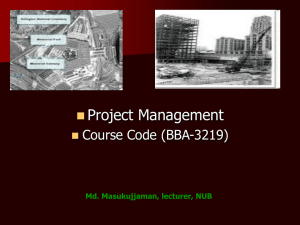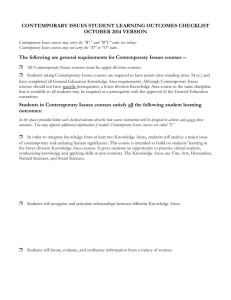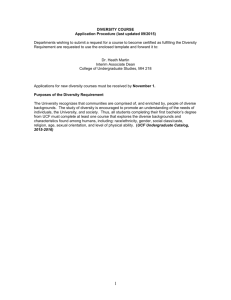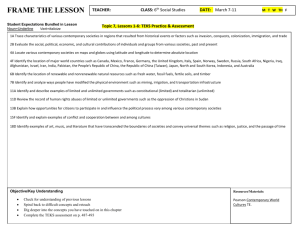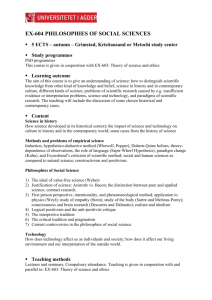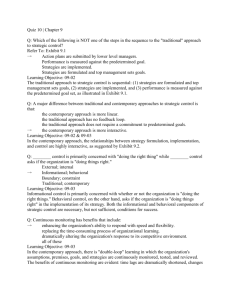Abstracts and lecturers biographies
advertisement
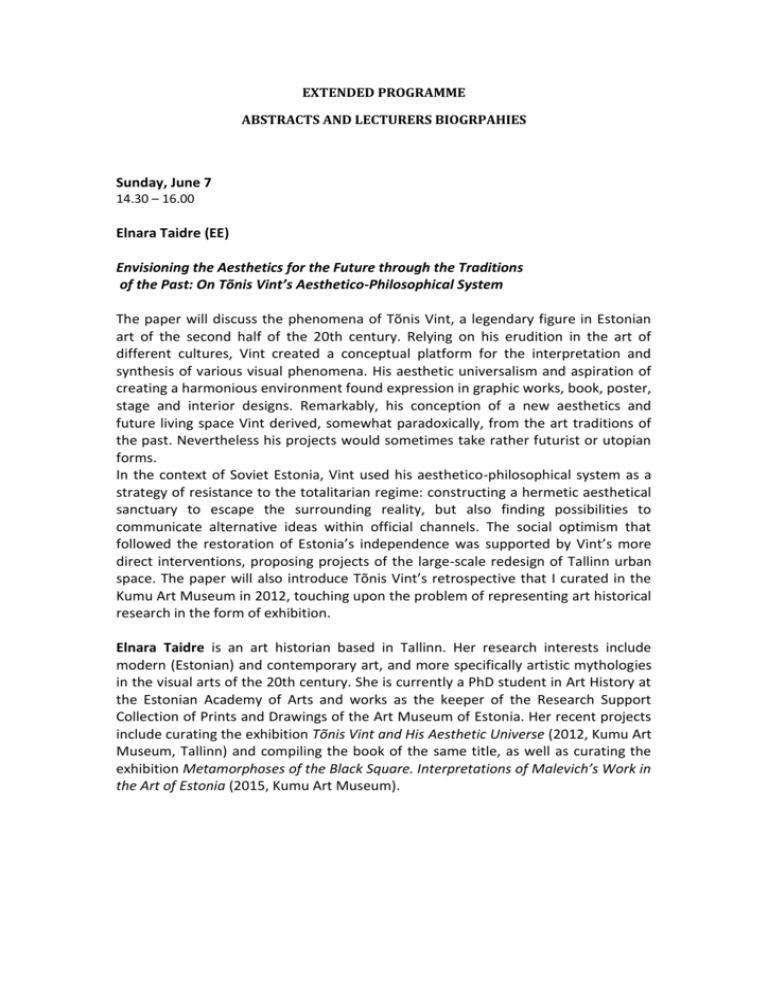
EXTENDED PROGRAMME ABSTRACTS AND LECTURERS BIOGRPAHIES Sunday, June 7 14.30 – 16.00 Elnara Taidre (EE) Envisioning the Aesthetics for the Future through the Traditions of the Past: On Tõnis Vint’s Aesthetico-Philosophical System The paper will discuss the phenomena of Tõnis Vint, a legendary figure in Estonian art of the second half of the 20th century. Relying on his erudition in the art of different cultures, Vint created a conceptual platform for the interpretation and synthesis of various visual phenomena. His aesthetic universalism and aspiration of creating a harmonious environment found expression in graphic works, book, poster, stage and interior designs. Remarkably, his conception of a new aesthetics and future living space Vint derived, somewhat paradoxically, from the art traditions of the past. Nevertheless his projects would sometimes take rather futurist or utopian forms. In the context of Soviet Estonia, Vint used his aesthetico-philosophical system as a strategy of resistance to the totalitarian regime: constructing a hermetic aesthetical sanctuary to escape the surrounding reality, but also finding possibilities to communicate alternative ideas within official channels. The social optimism that followed the restoration of Estonia’s independence was supported by Vint’s more direct interventions, proposing projects of the large-scale redesign of Tallinn urban space. The paper will also introduce Tõnis Vint’s retrospective that I curated in the Kumu Art Museum in 2012, touching upon the problem of representing art historical research in the form of exhibition. Elnara Taidre is an art historian based in Tallinn. Her research interests include modern (Estonian) and contemporary art, and more specifically artistic mythologies in the visual arts of the 20th century. She is currently a PhD student in Art History at the Estonian Academy of Arts and works as the keeper of the Research Support Collection of Prints and Drawings of the Art Museum of Estonia. Her recent projects include curating the exhibition Tõnis Vint and His Aesthetic Universe (2012, Kumu Art Museum, Tallinn) and compiling the book of the same title, as well as curating the exhibition Metamorphoses of the Black Square. Interpretations of Malevich’s Work in the Art of Estonia (2015, Kumu Art Museum). Sunday, June 7 16.30 – 18.00 Julijonas Urbonas (LT) Materialised Philosophy: Staged Arguments, Transtextuality and Material Hermeneutics in Art and Design What would happen to philosophy if its turn to things hypertrophied, and philosophical thought models turned to things? How would a philosopher-engineer, philosopher-cook, or philosopher-artist look like? What effect would it have on the human condition and material environment? By discussing these questions, I will speculate upon the idea of thingly philosophy, namely, its methodology. The latter will involve various methods, thought models, and approaches borrowed from science fiction, speculative design, futurology and my own practice. Special attention will be devoted to non-linguistic approaches and the tangible. After the talk, the participants will be invited to a brief workshop, in which some of the discussed methods will be tested. Julijonas Urbonas is an artist, designer, researcher, engineer, writer, Vice-Rector for Art at the Vilnius Academy of Arts in Vilnius, and PhD student in Design Interactions at the Royal College of Art, London. Since childhood, I have worked in amusement park development. In 2004, I became the head of an amusement park in Klaipeda, Lithuania, and ran it for three years. Having worked in this field — as a designer and engineer but also in ways that are artistic and philosophical — I became fascinated by what in my research I call 'gravitational aesthetics'. This experience is unavailable elsewhere, and I became intrigued by this under-developed topic. Since then the topic has been at the core of my creative life, from design/artistic work to scholarly articles. Most recently, this interest has matured into my PhD research, in which a unique creative approach of gravitational design is being developed. My work has been exhibited internationally and received many awards, including the Award of Distinction in Interactive Art, Prix Ars Electronica 2010, one of the most prestigious awards in media arts. My projects can be found in private and museum collections such as the permanent collection of the Centre for Art and Media Karlsruhe (ZKM). Beside my aforementioned research interests/activities, I also explore — through making, experimenting, and writing — experimental aesthetics of technologies and complex dialogues of art/design/technologies/philosophy/science and give lectures on these topics. I live in Vilnius. Sunday, June 7 18.30 – 20.00 Kirill Kobrin (GB) No Future? Two Versions after Cold War: Western and Post-Soviet Current obsession of contemporary art with the 'cabinets of curiosities' (doesn't matter from what particular historical period) draws us to the conclusion about the total absence of the very idea of future in this field of human activity now. Our task is to analyze to versions of this rejections of future, Western and post-Soviet. 1. Genre What makes a collection of random objects a piece of art? What makes art from fleamarket paraphernalia? Obvious suggestion – any combination of different things could become art only by applying (1) formal and (2) interpretational frames on it from outside. So there are frames that produce art from everything. 2. 'Framification' That draws us to the next step. If the art is not just the combination of objects but the frame which includes all them then what precisely could we call a piece of art? The objects? The way they combined? The frame which has been applied to them by an eye or a camera? Maybe art is just an image which is the result of above mentioned process? The answer to this question is the word 'action', the gesture of applying of the 'frames of art' to the accidental combination of objects – the gesture of cutting of the unnecessary and at the same time of interpretation of the remainders. Like in literary theory where a term 'discourse' which means a 'process' but not a 'static thing' had replaced static terms 'style', 'genre' and even 'literature', in the area of contemporary art 'an application of a frame', 'framification' should replace the term 'piece of art’ or 'object of art'. 3. 'Framification' is the rejection of future. Contemporary artist – as a scavenger, as a collector, and as a self-interpreter. Collecting litter of the past contemporary artist has no any idea of future. He just don't want it to come. Why? We will focus on two versions of this fear of future – Western (Damian Hirst) and post-Soviet Russian (recent contemporary art exhibition in Nizhny Novgorod Museum of Great Hopes). Kirill Kobrin writes fiction and nonfiction prose. Kobrin co-edits Moscow magazine of sociology, history and politics Neprikosnovenniy Zapas (Emergency Rations), and makes researches in cultural history of Russia, Great Britain and Czech Republic. Also, Kirill is very proud to be a Latvian columnist – for almost 7 years he writes monthly commentaries for Rigas Laiks. From 2013, he also contributes to Arterritory online journal. Kobrin is author of 15 books. His texts have been translated into several European and Asian languages. Kirill Kobrin was born in Gorky (USSR), graduated from University of Gorky, wrote his PHD thesis on history, spent 13 years in Prague working as a journalist for Radio Free Europe/Radio Liberty and eventually moved to London where he settled last year to enjoy life as a melancholic freelancer. Monday, June 8 10.00 – 11.30 Tellervo Kallainen (FI) The Making of Utopia In many of her participatory works Tellervo Kalleinen has used fiction as a tool. In her lecture she will tell about her movie projects Archipelago Science Fiction, The Making of Utopia and People in White – and make a little experiment with the participants of the lecture. Tellervo Kalleinen is a Helsinki based visual artist. Working with moving image, performances, games and events, she constructs situations which people are invited to join. Her artistic practice is based on creative collaboration and absurd collective adventures and her works often have a strong social psychological aspect, touching on the tension between individual and collective needs. Tellervo has worked closely with Oliver Kochta-Kalleinen, creating participatory projects, such as the globally popular Complaints Choirs. Their collaboration started in 2003 when they organized The First Summit of Micronations in Helsinki in the role of the curators of Amorph!03-performance festival. Out of the summit grew YKON (since 2005): The Helsinki and Berlin based YKON group encourages wild utopian envisioning – using game-like formats in facilitation. Tellervo is also a member of performance group JOKAklubi (since 2009) and the Speech Karaoke Action Group (since 2010). She makes music with several musicians, and in 2014 she released a vinyl under the name Kaukaisu. With Oliver Kochta-Kalleinen she received AVEK award in 2012 and in 2014 they received the ARS FENNICA – the biggest art award of Finland. Monday, June 8 14.00 – 15.30 Tomas Čiučelis (LT) The Conditions of Catastrophe Tomas Čiučelis will discuss how the notions of promise, change, hope, and future shape our thinking today, when it is seemingly impossible to escape the increasingly complicated modes of accelleration and when the inclusion into the global capitalism appears inevitable. By drawing on Martin Hagglund’s reading of Derrida, Tomas will introduce the concept of catastrophe an affirmative mode of thinking the event as such. Tomas Čiučelis is a philosopher, translator, and interdisciplinary researcher. Finished Media Art studies at the Vilnius Academy of Arts, currently a PhD candidate in Continental Philosophy at the University of Dundee. Books translated and published in Lithuania: Lev Manovich, “Language of New Media”, and Noam Chomsky, “Hegemony or Survival.” Research fields: mediation, philosophy of technology, alterity and language. Actively following the developments in speculative philosophy. Monday, June 8 16.00 – 17.30 Aigars Atvars (LV) Invention Methodology TRIZ and its Proposals for Forecasting the Future Invention problem solving methodology TRIZ was developed in the 1950s-80s in the Soviet Union with the aim of solving various technical problems. The essence of the methodology was the realisation that systems develop according to specific principles, and the reason their development stops is an encounter with a contradiction. If that contradiction is solved, the system can develop further. TRIZ methodology identified proposals for various ways of solving contradictions. If we know the principles according to which systems develop, we can forecast the way a particular system will develop. That allows us to forecast the future of various systems, to 'look into the future.' The main principle of system development is 'pursuit of ideality' – a state where the system becomes minimal (or virtually disappears), simultaneously retaining its function. For example, these days notebooks, calculators and photo cameras have virtually disappeared – they have 'entered' into mobile phones. Similar 'disappearance' can take place with other things. If artists could forecast such disappearance, it would enable the creation of futuristic scenes that appear instructional and interesting to the contemporary human. Art would thus be able to look into the future. Aigars Atvars is project manager and leading researcher at the Institute of Atomic Physics and Spectroscopy at University of Latvia. He earned his PhD in physics in 2008 in the sub-sector of laser physics and spectroscopy. He has acquired additional education in theology and business management. He has cultivated an interest in talented thinking and development of abilities. In this context, A. Atvars' attention turned to invention problem solving methodology TRIZ, which he has been studying since 2007. A. Atvars has experience in the arts – in primary school he attended drawing classes, later learned to play the accordion, sang in a choir. In the last 5 years he has self-learned to play the piano and compose music. Monday, June 8 18.00 – 19.00 Ģirts Rungainis (LV) The Tomorrow of Europe through the Perspective of Political Economy Girts Rungainis is an economist. He was educated in a B.Sc. program in the University of Latvia, specializing in Mathematics and Physics, and in the University of Stockholm (M.Sc. program), specializing in Finance and Banking. Rungainis was one of the founding partners and the President of the German–Latvian Bank, now Swedbank (1992–1996) and the President of the Trust Commercial Bank (1997– 1999), a member of the Board of the Association of Latvian Commercial Banks (1993–1999) and Baltic International Airlines, as well as advisor to Prime Minister of Latvia in 1999. Currently, he is a member of the Council of Valpro Corp – the leading fire extinguisher, fire extinguisher shell and metal canister producer in Central and Eastern Europe. Tuesday, June 9 10.00 – 11.30 Lauren M. Rhodes (LV / USA) Artistic Practice and (Un)lived Memory: Exploring the Intersection Between the Postcolonial and the Postsocialist This lecture will explore the connections and confluences between the postsocialist and postcolonial within artistic practices. Utilizing a form of ethnographic critique (via Lippard 2010, Rosaldo 1989, and Siegenthaler 2013), the lecture will pay particular attention to the ways in which artists with connections to postcolonial and postsocialist spaces relocate (lived or not lived) memories of these experiences through the prism of related topics and issues. Keeping the larger theme of the LCCA International Summer School in mind, the lecture will critically investigate how artists look to both the past and the future between inception and display. This investigation will include a discussion on the works of Irina Botea, Yinka Shonibare, Janek Simon, Kara Walker and Ala Younis. Finally, the lecture will conduct a reading analysis of two texts: Zsuzsa Gille’s (2010) “Is There a Global Postsocialist Condition” and Cameron McCarthy’s and Greg Dumitriadis’ (2010) “The Work of Art in the Postcolonial Imagination”. Lauren Monsein Rhodes is an acting assistant professor in the Cultural and Social Anthropology Program at University of Latvia. She has worked at numerous museums and arts institutions in the United States, including The Studio Museum of Harlem (New York, NY), The Kitchen (New York, NY) and Weeksville Heritage Center (Brooklyn, NY). Lauren's research interests include art institution and community relationships, socially engaged art, and the discourse of difference. Tuesday, June 9 14.00 – 15.30 Laine Kristberga (LV) The Archival Desire and its Relationship to the Future The theoretical framework of this lecture will be focused on the archival discourse and knowledge-making practices, accentuating the futural dimension of the archive. The students will be offered an overview of the archive over various disciplines, including contemporary art, but the tone for the discussion will be set by Jacques Derrida’s work Archive Fever: A Freudian Impression (1995). For Derrida, the archive is oriented to, just as it is defined by, a peculiar structure of temporality. It marks a space of anxiety about the possibility of loss: the archive exists only as an anticipation of the loss of history; as such, it works proleptically to preserve what will inevitably be lost. The temporal valence of the archive thus is precisely futural: “The archive …will never be either memory or anamnesis as spontaneous, alive and internal experience. On the contrary: the archive takes place at the place of originary and structural breakdown of the said memory” (Jacques Derrida, Archive Fever: A Freudian Impression. 1995, p. 11). Laine Kristberga is an art critic, scholar and writer, an author of numerous academic publications in Latvian and English. She has graduated with a Master’s degree in English Literature and Culture from the University of Latvia and with a second Master’s degree in the History of Visual Media and Film from the Birkbeck, University of London. Currently Laine Kristberga is a PhD candidate at the Art Academy of Latvia and writing her dissertation on the subject “Documentation of Performance Art in Latvia 1970s – 1990s”. Laine Kristberga is a lecturer at several higher education establishments in Latvia, where she is reading lectures on various arts and humanities-related subjects, including art and business, anthropology, critical discourse analysis and writing, performance art and photography. Tuesday, June 9 16.00 – 17.00 Agnė Bagdžiūnaitė (LT) Cognitive Table: The Imaginaries Last summer in Žeimiai our collective started to look for people from the local community who would have a small business related to food industry. We collected some produce to present the production for the public coming to Žeimiai town festival, which is celebrated every year. We thought it will finally work for us to be included in the local community as such. It was our hundred and first try. In my presentation I will talk about our failures and miscommunications experienced through almost 10 years to approach the community of Žeimiai. What is the community and how it is supposed to work? What do we imagine and what "they" imagine? Lately Agnė Bagdžiūnaitė is occupied with Residencyo-yo (Yo-yo is a part of Zemat activity) projects as cultural worker, also finishing her first year of Masters in Vytautas Magnus University in political science. Some time ago, together with a partner they were running the info-shop Taskas in Vilnius, where they organized reading groups, open kitchen, screenings and performances around the topics of gender and sexuality. She was born in a working class family but decided to study arts in her early childhood. She fulfilled the plan and entered Vilnius Academy of Art as a future painter. After the graduation, she moved to live in the village and started ‘twoperson’ (at that moment) collective Zemat (Zeimiai Technical College of Esthetic Art and Anonymity). She has continued her arts education with Masters in Stockholm Royal Institute of Art. Tuesday, June 9 18.30 – 19.30 Ivars Drulle (LV) Based on True Stories This lecture is about the manner in which we look at 'true stories'. It is clear that history is not objective and can change beyond recognition, based on the narrator's position. Our history and everyday life contains many 'true stories' that the society avoids discussing publicly yet debates passionately in the kitchen. When these kitchen stories, or, simply — reflections, appear in the public space, though, they can cause unpredictable consequences. The lecture will tell about the experiences of working with burning topics and the consequences that may arise, when labelling an artwork as 'based on true stories'. Ivars Drulle is an artist from Latvia. He began studying sculpture at the Art Academy of Latvia in 1996 and Drulle received an MFA in Fine Arts from the University of Montana 2003. He returned to Latvia and has since been the chairman of the Form Design Department at the Riga Design and Art School. Ivars works in various mediums often involving sounds. Most of his projects are either large scale and sitespecific or tiny miniatures and maquettes. His appearances include the 2nd Moscow Biennale for Young Art (2010), a collateral exhibition at the 53rd Venice Biennale (2009), Bremen State Gallery (2010), Beaufort Triennial in Belgium (2012) and numerous shows in USA, Russia, Sweden, Belarus, Germany and other countries. Wednesday, June 10 10.00 – 11.30 Voldemārs Johansons (LV) Data and Proportions in Composition Over the last years I have realised several larger format sculptural works that encompass subjects, to the research of which I have dedicated significant time and effort. These works share an approach characterised by an architectonic reading of space and a constructive approach to composition, resulting in the union of sound and space. In conjunction with perspective and the nature of human perception, they form a landscape, whose perception changes significantly depending on the observer's viewpoint. Another theme from the range of my creative interests is the formation of shapes and ornaments in the course of natural processes – according to organisational principles that are much broader than the subjective viewpoint and exist without a necessity of being observed. The use of these phenomena in the process of composition can be realised as translation and application of data from observations of physical phenomena, giving this material a spatial and sonic dimension. Artist, sonologist and composer Voldemārs Johansons (1980) works with audio/data in forms of composition, installation and performance. He has graduated from the Institute of Sonology at the Royal Conservatory of The Hague and the Latvian Academy of Music. His work deals with acoustics and sound processing, examining aspects of spatiality, physicality and interaction in context of real and virtual environments and their hybrid intersections. With his sound sculptures and audiovisual installations, he has taken part in exhibitions, music festivals, performances and new media events in Latvia and abroad. He also has done sound and music productions and created sculptures for several theatre performances and productions. Wednesday, June 10 12.00 – 13.00 Jaak Tomberg (EE) This is Tomorrow? On the Contemporary Convergence of Realism and Science Fiction The lecture will study the hypothesis that as the contemporary late-capitalist cultural environment becomes increasingly technological, its literary realism, aspiring towards a plausible mimetic reflection of this environment, becomes increasingly science-fictional. It has been empirically noted some time ago that due to the intensification and acceleration of technological developments in the contemporary western culture, the cognitive horizons of futurity have drawn decisively close to the present: the future has 'collapsed onto the present', and science fiction, in some of its forms, has thereby lost its potential to project plausible futurist visions formerly common to the genre. I will study this premise through the poetic analysis of William Gibson’s 'Blue Ant Trilogy' (the novels 'Pattern Recognition', 'Spook Country', and 'Zero History') and discuss the utopian implications of the contemporary close relations between realism and sci-fi. Jaak Tomberg is researcher of literary theory at University of Tartu. His current fields of research are literary utopias, philosophy of literature, theory of criticism, and contemporary relations between realism and science fiction. Besides theoretical work, he has translated fiction and literary theory, edited the Estonian Avant-garde magazine Vihik and written plays. Thursday June 11 11.00 – 12.30 Dovilė Tumpytė (LT) Mind-Specific Art: A Thought Experiment of 21st Century Art Practice? Mind-specific art – is it an art practice at work or a bare theoretical concept? The strongest incitement to think of emergence of an extraordinary practice in the art world, which I put under the working concept of 'mind-specific art now', came after an hour-long ‘silent and blind’ walk in the Venice Biennale in 2013. It was a silent perceptive experience for a guide and a spectator with eyes closed, the art piece Walk, Eyes, Hands (the city) by Myriam Lefkowitz. Guiding by touch in the city of Venice provided me with a phenomenal self-perception and substantially changed my perception of reality itself in such a way that I could never expect from art. That experience recalled the idea, earlier expressed by curator Raimundas Malašauskas, that he treated mind as any other medium in arts. Such questions as ‘how spectator’s brain could become a venue for an exhibition?’ and ‘how dematerialization (of art) could be pushed to the limit?’ prompted him to curate the ongoing project Hypnotic Show (since 2008), in which the artist and hypnotist Marcos Lutyens induces the non-object exhibitions directly to the brain of the audience by using hypnosis as a vehicle. It was obvious then: these art practices possess something which is opposite to dominant critical thinking in culture, but nevertheless is extremely powerful and relevant to contemporaneity, and that should be discussed. Is the mind of the participant being used as a matrix for art production? Does an artwork become a ‘black box’? What is the new role of the participant who has seemingly undergone a radical transformation? How mind-specific art contributes to the neuro-anxious culture of the 21st century? Readings/watchings: Pascal Rousseau, 'Under the Influence: Hypnosis as a New Medium', in: The Book of Books. dOCUMENTA (13): Catalog 1/3, Edited by documenta und Museum Fridericianum Veranstaltungs-GmbH, 2012, p. 515–517. Art critic Jan Verwoert’s lecture ‘Artists, what is your value? On Seduction Value and Metabolism’, https://www.youtube.com/watch?v=n15_Lr4gEko Dovilė Tumpytė is an art critic, curator and lecturer based in Vilnius. She has curated and organized modern and contemporary art projects, series of lectures and seminars at the National Gallery of Art (2011-2015); was head of the Contemporary Art Information Centre (2007-2011), focused on collecting and disseminating information about Lithuanian modern and contemporary art (department of the NGA). Since 2003, contributes to the Lithuanian culture press, Lithuanian and international art exhibition catalogues. In 2013 she enrolled in Art Criticism Doctoral Studies at the Vilnius Academy of Arts. Thursday June 11 13.00 – 15.00 Rasa Šmite, Raitis Šmits / RIXC (LV) The Ecological Perspective in Contemporary Media Art Creative Workshops – Building a Bacteria Battery In a contemporary media art today we are facing the transformation from new media to post media situation, which is characterised not only by equality and convergence of different media technologies (accordingly to Peter Weibel), but also by growing interest into science, biotechnologies and ecological issues. Artists who in the 90s were in the contemporary art avant-garde exploring digital frontiers, today are among those, who in a profound way are engaged in a quest for a more sustainable future. By working together with people from very different background – scientists and farmers, environmental experts and innovators in technology, urban gardeners and rural communities, cultural heritage researchers and future visionaries, artists such as those from Renewable Network are building radically new perspective, which we call “techno-ecological”. In our lecture we will be tracing back into the history of art, science and technology, following their parallel lines of development and highlighting crossovers. By analysing examples from Renewable Network and our own work, as well as from three more recent RIXC's curated exhibitions – Techno-Ecologies (2011), Save As (2013) and Fields (2014) we intend to show the shifts from new media to post-media conditions, and from technoscientific to techno-ecological paradigm. Bacteria Battery The idea behind the “bacteria battery” - art and science research project by RIXC is to explore the relations between biological systems, information technologies and green energy production. Bacteria battery workshop is an experiment with the 'nextgeneration' bio-technology (called – microbial fuel cells / MFC) and how it can be approached and interpreted through artistic perspective. MFC technology is based on a bio-electrochemical system that converts chemical energy to electrical energy by using microorganisms. Bacteria who live in a dirty water, mud, that is, everywhere where they can 'access' and 'eat' organic matter and where there is nearly no oxygen, release free electrons. During the workshop we will show how to make a “living battery”, in which the electricity is produced from bacteria living in a mud. We also will be introducing how this technology have been used in science (e.g. deepocean research, medical devices) as well as in the arts – we will be showing how us – the artists from RIXC for several years now have been collaborating with scientists from Solid State Physics Institute of Latvian University in building networked sound art installations. Rasa Šmite and Raitis Šmits are internationally recognized artists, curators and cultural innovators, working with science and emerging media technologies since the mid 90s. Rasa and Raitis are the key founders of RIXC Center for New Media culture, organizers of international Art+Communication festival, and editors of Acoustic Space peer-reviewed journal series. Raitis Šmits has a doctoral degree in the arts, and works in Latvian Academy of Arts. Rasa Šmite holds her degree in sociology, and is associated professor in Liepāja University's New Media Art programme, and researcher in Art Research Lab. Rasa and Raitis are also giving lectures in Riga Stradins University, and extensive lecturing in the festivals, conferences and other universities locally and internationally.

